Advertisement
There's nothing prettier than teak on a boat, but it requires some upkeep. Here are some tips and products to help keep it looking great.


The natural, unfinished teak on the sailboat above is a beauty. But with brightwork varnished and the deck oiled (above), she sparkles! Here you can see the difference in a teak deck that's been sanded (top) and unsanded (bottom).
Teak maintenance is a love-hate affair for most boat owners. We love the warm, golden glow of a freshly cleaned deck, but not so much the elbow grease required to keep it so. Let's take a look at some cleaning tips that can help bring your tired teak back to life.
The Versatility Of Teak
Due to its resistance to deterioration, rot, and insects, teak is one of the few things onboard that allows a boater to decide the amount of effort they want to spend maintaining it. Many prefer the golden glow and accentuated grain highlighted by properly oiled or varnished teak deck or trim, viewing the additional work required to achieve it as time well spent. Others take the more laid-back approach of letting it attain a natural silver-gray color, safe in the knowledge that less than 1/100 of an inch below that weathered-gray look lies beautiful, oily wood (just be aware that thinner pieces of teak trim can become severely sun-dried and brittle or crack if neglected for too long).

Regardless of your chosen maintenance philosophy, at some point a reason will arise to give your teak a thorough cleaning, be it spring commissioning, selling the boat, or readying the wood for oiling or varnishing. Ironically, cleaning is when teak is most likely to sustain damage due to the use of harsh chemicals and overaggressive or incorrect cleaning methods. Improper cleaning with pressure washers, stiff bristle brushes, or harsh chemicals can remove the soft, lighter-colored grain of the wood, creating a washboard effect. Once that occurs, these ridges (which more readily trap dirt) can only be removed by sanding, which again removes more wood in a vicious cycle of owners loving their teak to death.
Teak-Cleaning Tips
Most teak dies an early death, not from neglect, but from improper cleaning by well-meaning owners. Although you should always follow the manufacturer's recommendations for any cleaner or product being used, here are eight general tips on proper teak care that will serve you well in all situations.
- Use the mildest cleaner possible to get the job done.
- Always wear recommended protective equipment (e.g., rubber gloves, goggles) when handling teak cleaners.
- Protect adjacent areas and finishes while cleaning. Gel teak cleaners have an advantage in this regard, providing you more control during application on horizontal or even vertical surfaces. Teak cleaners can damage anything from gelcoat and paint to anodized aluminum and even chrome fittings. Wet adjacent areas with water prior to cleaning and keep them wet, being sure to rinse all areas thoroughly (especially those being cleaned) as any residue will continue to eat away at whatever surface it remains on.
- When cleaning teak, scrub across the grain of the wood with a 3M Scotch-Brite pad. A soft, polypropylene bristle brush will do in a pinch — just remember to scrub lightly and never with the grain.
- Badly worn teak should be lightly sanded to smooth the wood's surface. While sanding also removes some of the wood, a smooth surface is easier to properly maintain and can increase the life of teak by exposing less wood to the elements and preventing the grain from trapping dirt and airborne contaminants.
- Keep teak wet while cleaning. An overcast or even drizzly day is better than a blazing sunny day, as it helps prevent the area from drying out.
- Use two-part cleaners as a last resort only, and then use sparingly.
- Keep cleaned and/or treated teak covered if possible, to prevent UV light and weather damage.
The Teak Cleaning Enigma: Less Is More
A quick look at any well-stocked chandlery will show there's no shortage of teak cleaners. One-part, two-part, pastes, powders, gels — the list seems endless. But which one to use? Simplify selection by remembering your teak cleaning prime directive is to start with the mildest cleaning product that looks like it has a chance of success, then work your way up (as required) to stronger cleaners that can do the job with as little damage to the wood as possible.
One-part cleaners tend to be less harsh than two-part products, but may require longer dwell times (the time required to work after the product is applied), multiple applications, or simply lack the cleaning power of their two-part brethren, especially when faced with ultra-gnarly teak.
Two-part cleaners should be considered the "nuclear option" of teak cleaning due to the harsh chemicals and toxic nature of most. Sure, they can clean even the nastiest piece of teak, but they do so by removing some of it in the process. They should be used sparingly and only after milder one-part cleaners have been tried. The first part of a two-part cleaner contains the primary cleaning agent, while the second part (depending on the product) may provide additional cleaning power, contain a wood brightener (to lighten and impart a more uniform color), or simply act as a neutralizing agent for the first part.
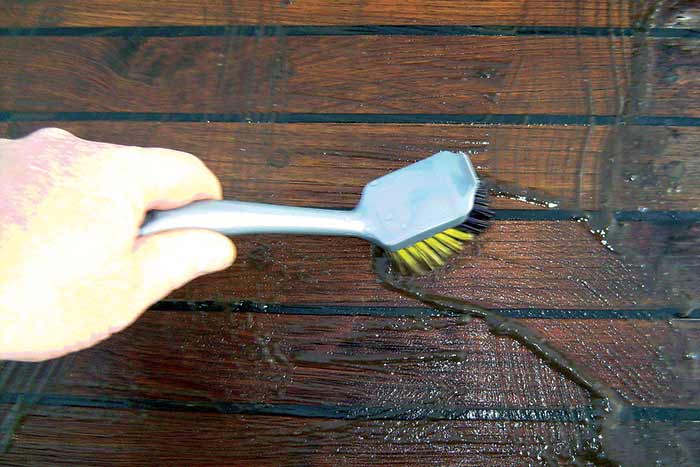
Powering off the grime on teak decks with a cleaner and brush. Remember: Less is more.
Other factors to consider when selecting a teak cleaner include ease of application, harshness, dwell time, and "greenness" or environmental concerns. For example, products that have to be mixed require more preparation and time than one that can be applied directly from the container. The same is true for a cleaner that requires a 20-minute dwell time verses one a user can start scrubbing on immediately. On the flip side, many users may be perfectly content to wait that extra 20 minutes if the cleaner is milder on both crew and boat (meaning they don't have to remove teak trim due to worries about damage to adjacent gelcoat or painted surfaces), cheaper, or more environmentally friendly.
While teak cleaners are typically used in preparation for varnishing or oiling, most commercially available teak cleaners are simply too harsh for regular daily or weekly cleaning. For routine cleaning you'll find that sudsy ammonia or a solution of water and mild detergent (such as Original Pine-Sol cleaner) will compare well to most teak cleaners while being a lot easier on the wood, surrounding surfaces, and the environment.
On The Shelf
Here's a sample market scan of both one- and two-part cleaners.
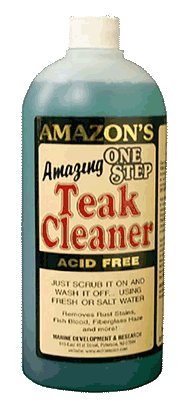
Amazon's One-Step Teak Cleaner
Claims to easily remove dirt, rust stains, fish blood, and other sorts of grease and grime from weathered teak. It's billed as an acid-free formula that won't harm fiberglass or damage the teak's soft grain, while enhancing the natural texture of the wood. Application instructions: Wet area to be cleaned with fresh- or saltwater (including adjacent areas that the cleaner may also contact), then scrub or agitate as needed with a soft scrubbing pad. Rinse with water, then repeat if necessary. Safety precautions include wearing protective gloves and washing hands thoroughly after use. The manufacturer recommends following with an application of Amazon's Teak Prep (a brightener) followed by a good oiling with Amazon's Teak Oil. 32 oz., $15.99 | MDRAmazon.com
West Marine One-Step Teak Cleaner & Brightener
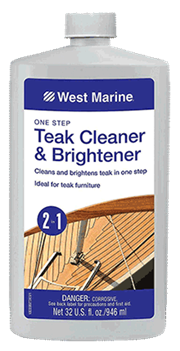
Advertised for cleaning lightly soiled teakwood surfaces. For badly stained or weathered teak, West Marine's Heavy Duty Teak Cleaner Kit is recommended. Product literature states that it won't harm wood and that it removes stains, oils, and so on, while restoring teak to its natural color. It also states its intended for use on teak wood only and that it may damage gelcoat, paint, and metal surfaces.
Application instructions: Spray teak with water, then apply cleaner, allowing it to penetrate for 2 to 3 minutes. Scrub the wood with a soft-bristled deck brush, keeping the surface wet while cleaning. Rinse the wood thoroughly with water. Keep all adjacent surfaces wet with water and immediately rinse thoroughly if accidental contact occurs. West Marine recommends following up with its Golden Teak Oil. 32 oz., $22.99 | WestMarine.com
Iosso Teak Cleaner
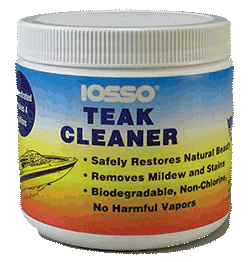
Comes as a powder (a 16-ounce jar makes 4 gallons of cleaner) that, per product labeling, safely removes dirt, black algae, and mildew stains in one easy step without harsh chemicals. Iosso states that its product emits no harmful vapors; is biodegradable and nontoxic; won't harm fabrics or colors, vinyls, canvas carpeting, metals, paints, fiberglass, or plastic surfaces; and is gentle to skin (although product labeling recommends avoiding prolonged contact). Application instructions: Mix up a batch of cleaner using the provided measuring scoop — one scoop makes a quart, four scoops a gallon, and so on, when combined with water. The instructions state to use a plastic container, mix only what you'll need for the job, and dispose of any unused solution afterward. Thoroughly mix until the powder is completely dissolved (warm water is recommended for best results), then apply the solution on any horizontal or vertical surface to be cleaned. Cool surfaces with water prior to application if hot. Let stand for 10 minutes or longer while keeping the area wet with solution (thoroughly brushing it into the wood) then rinse with water. Extremely weathered wood may require a second application. 16 oz., $15.25 | Iosso.com
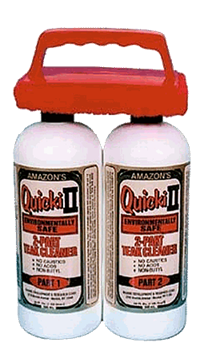
Amazon's Quicki II 2-Part Teak Cleaner
Per the manufacturer, this cleaner is environmentally safe (contains no caustics or acids and is non-butyl) and won't harm fiberglass. Part 1 takes care of the deeper stains, grease and grime, while Part 2 follows through with surface cleaning and brightening agents. Each kit includes a teak scrubber for easier teak cleaning. Application instructions: Wet the area to be cleaned, then apply Part 1 full strength and agitate with provided scrubber; let sit for 10 minutes, then rinse. Apply Part 2, agitate for final dirt and grease removal, let set for 15 minutes and rinse thoroughly. Follow-up manufacturer's recommended product is Amazon's Golden Teak Oil. 2 x 32 oz., $33.30 for set | MDRAmazon.com
West Marine Heavy Duty Teak Cleaner Kit
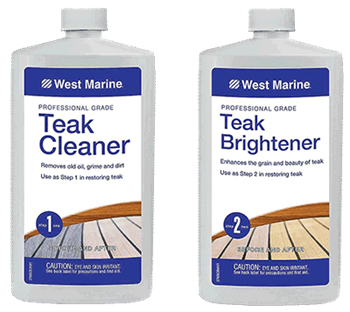
Advertised for cleaning badly stained or weathered teak. Step 1 chemically attacks stained teak, while step 2 neutralizes step 1. Instructions state the product will not harm seam compounds, however, the label also says it may damage gelcoat, paint, and metal surfaces.
Application instructions: The manufacturer recommends wearing rubber gloves and eye protection when using this kit. First, wet the surface to be cleaned as well as the surrounding areas (including hull and deck), then apply Step 1 Teak Cleaner. Spread and agitate lightly with a synthetic deck brush. As the area darkens (in 3 to 5 minutes), scrub lightly. Rinse thoroughly with water, then apply Step 2 and spread evenly with a deck brush. Agitate lightly, then as the deck turns a light golden tone, hose off all surfaces thoroughly (including the hull). 2 quarts, $47.99 | WestMarine.com
